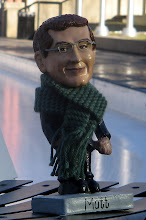 Yesterday my brother-in-law Elliot was describing the miracle that is bread - how these four simple ingredients (flour, water, salt, yeast) can create an endless variety of forms, tastes, textures. Elliot is an amateur breadmaker himself - he was finishing a loaf of flaxseed bread as he was telling me this - and he strongly recommended Peter Reinhart's The Bread Baker's Apprentice. I read the first chapter, which is inspiring stuff. For the mind as well as the appetite.
Yesterday my brother-in-law Elliot was describing the miracle that is bread - how these four simple ingredients (flour, water, salt, yeast) can create an endless variety of forms, tastes, textures. Elliot is an amateur breadmaker himself - he was finishing a loaf of flaxseed bread as he was telling me this - and he strongly recommended Peter Reinhart's The Bread Baker's Apprentice. I read the first chapter, which is inspiring stuff. For the mind as well as the appetite.I probably haven't got enough space in my kitchen or my life for a new hobby right now, but I do think there are some fascinating parallels between bread making and string playing. String players, like bread makers, work with four basic elements - the speed, weight, placement, and angle of the bow - to produce a multitude of timbres. The way those variables are combined, and the artful touch with which they are applied, make the difference between a tasteless lump of stale dough and the complexly grained, beautifully risen loaf of an artisan. If we were to quantify those variables, measure the difference between a novice violinist and Heifetz, we might not find a great deal of difference. Yet the same ingredients take on a whole different life in the master's hands.
Trying to quantify all the variables would probably tell us very little, about either bread or the sound - since the essence is something living, unquantifiably, in the air all around us. This is literally the case with yeast - it is in the air we breathe, collecting and growing where we allow it to (and sometimes where we would rather it didn't). The taming of this living, changing, complex organism makes bread an art as well as a science. It's a strange and mostly symbiotic relationship, since without yeast we wouldn't have the "staff of life."
Before yesterday I had never heard that proverb - I thought at first that it was a typo for "stuff of life." What this staff represents, I'm still not sure. I get the sense that it's older and more mysterious than some of those other food slogans (e.g. "it's what's for dinner," "got milk?", etc.) Maybe age and mystery are bread's unlisted ingredients - no other food seems to lend itself so easily to metaphor and ritual.
Maybe that's why I've been gnawing on this analogy to string playing. A clarinetist friend commented that we can see everything a string player does - our arms and fingers are in plain sight, unlike the clarinetist's lungs and air pathways. And yet it still strains the mind to account for the sounds those gestures produce; they really do seem to emerge from some kind of metaphysical alchemy rather than discrete physical laws of vibration. Returning from a few days without practicing, I'm sometimes astounded that the things I'm attempting are even possible. I suppose that thinking about the lump of dough majestically rising at least gives me a hopeful metaphor.


 Technorati Link Count: no. of blog reactions to this post
Technorati Link Count: no. of blog reactions to this post
2 comments:
One question though-- don't you realize that most anyone can make good bread? Likewise is making music only acceptable for the very best who can contemplate all the academic ideas and all the theory? Or is it okay to go to a contradance and enjoy the fiddle player and the bassist who only knows a couple chords? It isn't Edgar Meyer, but it is people making nice music. It seems like you're saying the only thing worthwhile is the very best. Yet i think it would be wonderful if everyone took up an instrument and enjoyed it to the fullest or danced or wrote poetry. It's like that in Ecuador among the Quichua--everyone plays. sincerely, a musician
Point well taken - just because it's an art, doesn't mean anyone can't do it well. Or that we need to understand all the physics to engage in the act, much less enjoy it. I don't know anything about the Quichua, but their inclusive approach to art sounds like a recipe for great music, and joyful living.
Thanks for reading, and for your comments!
Post a Comment